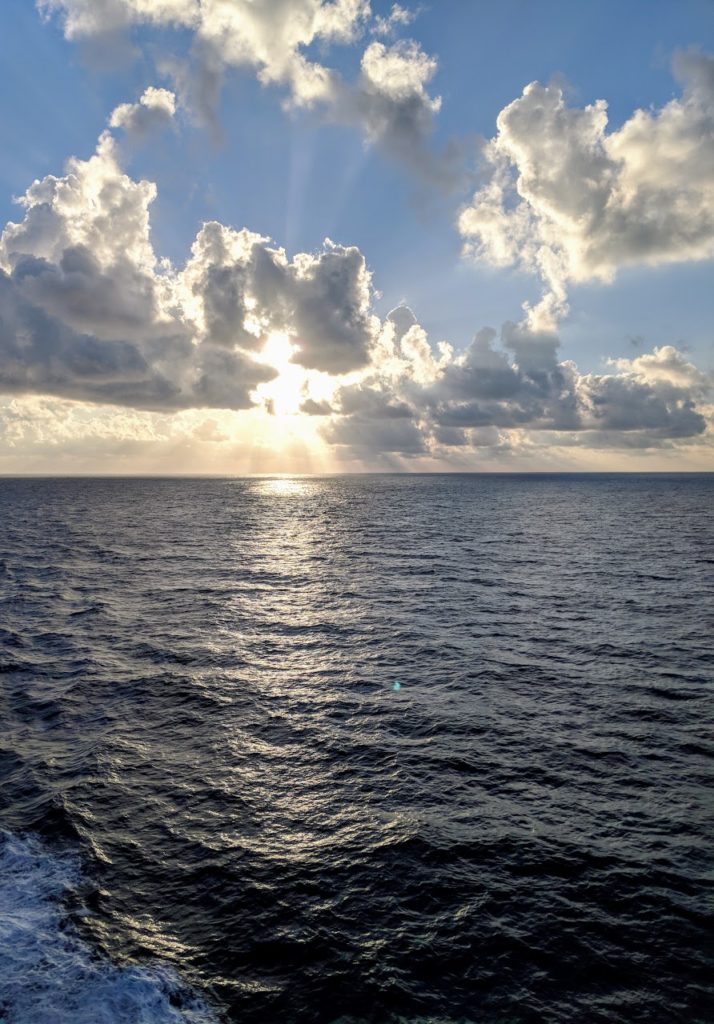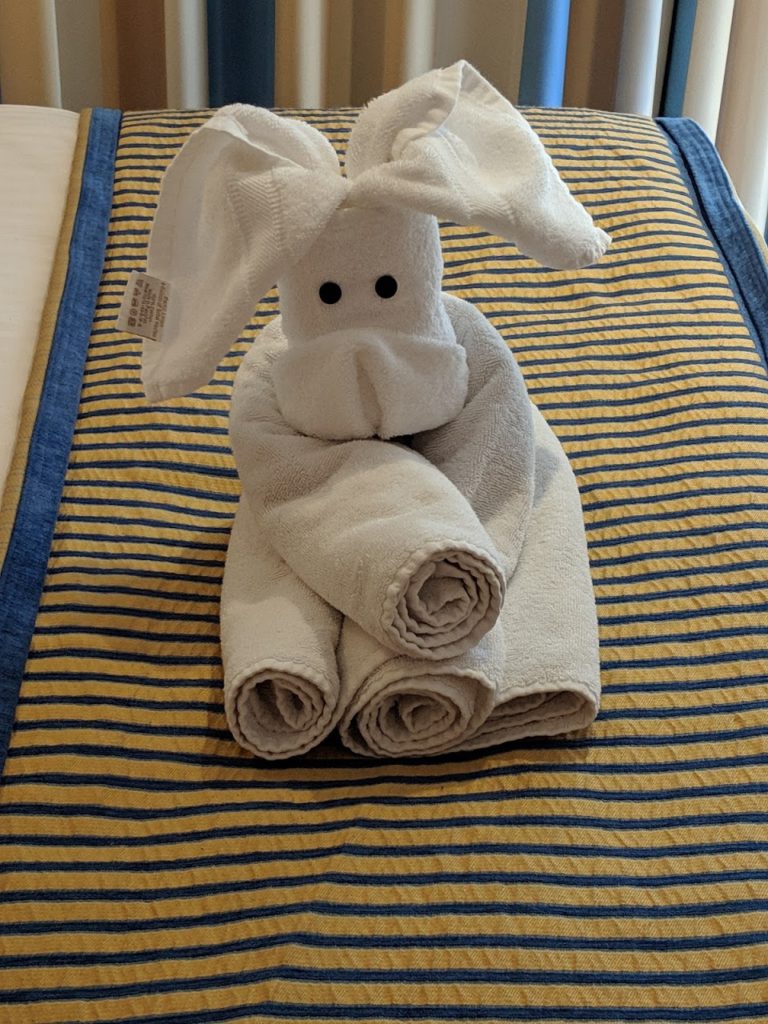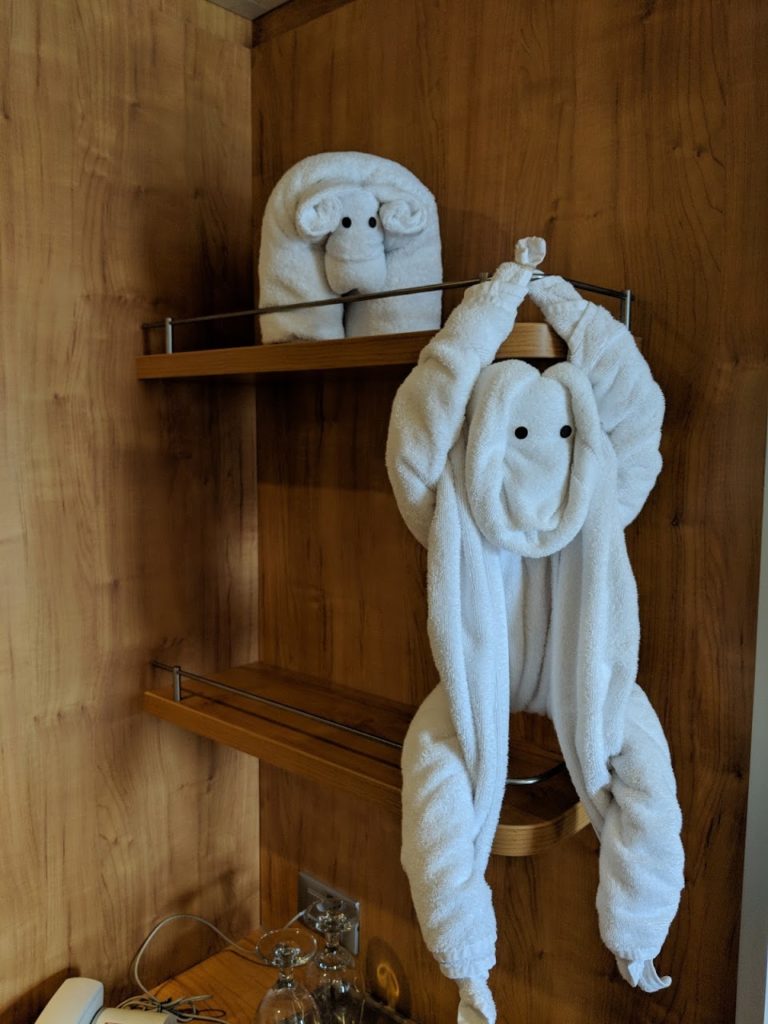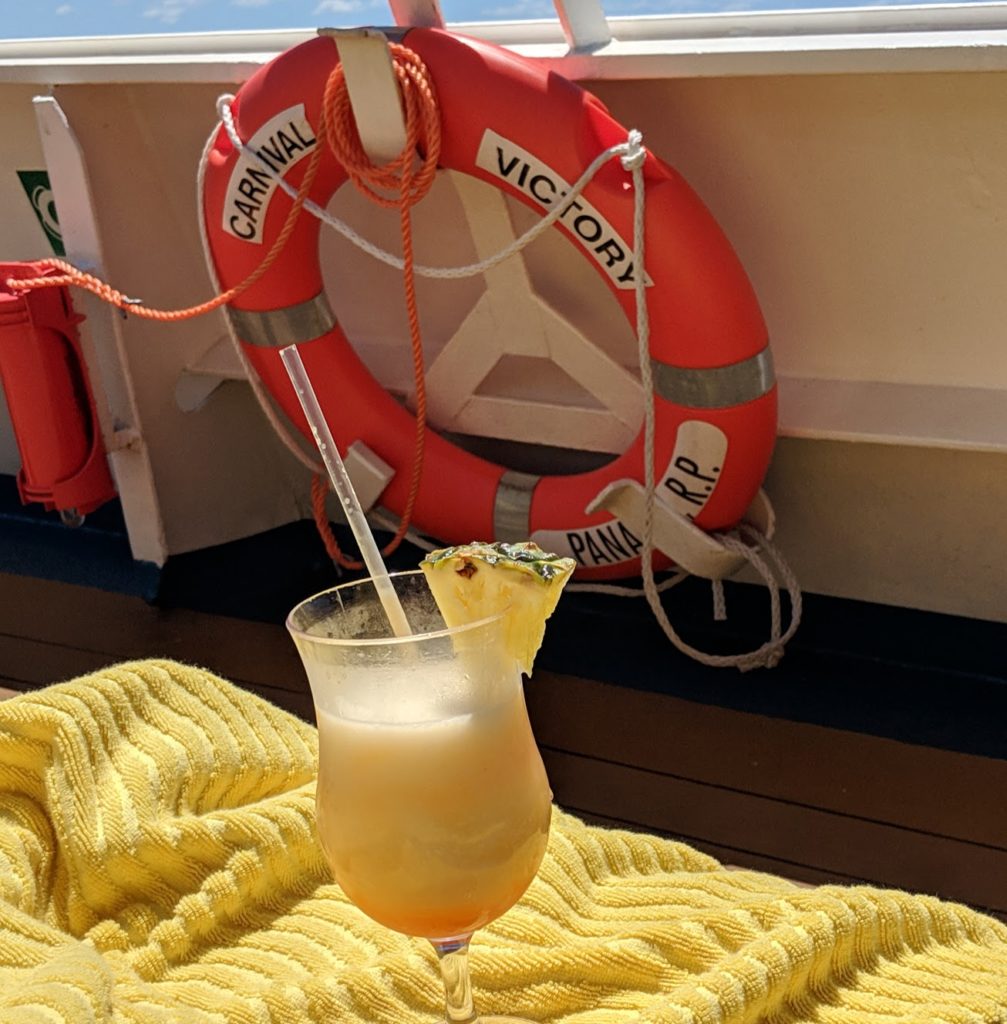All Aboard!
“It’s not the destination. It’s the journey.” Powerful quote. I’m pretty sure that when Ralph Waldo Emerson* spoke, or wrote, those words he was not thinking of a cruise ship. But, as saying goes, if the shoe fits …
Steven and I just returned from a 5-day/4-night stay on—yes—a Carnival ship. “The Fun Ship” is their motto, and I have to say—as corny as that sounds—it’s true. Steven and I try our best to go on one Carnival cruise a year and I’m trying to make sense of what draws us to those ocean trips.
What is it about cruising that is so appealing to us—and to so many others?
There’s something magical about a cruise. Magical, as in magical thinking. For, when you sign on to take a cruise, you are not only agreeing to pay the bill, you are agreeing to believe. To leave all your cares—and much of your critical thinking—at the port. You don’t worry because you know all too well that your cares (and your brain) will be waiting for you when you disembark. But for now … for the 5 days/4 nights … you are free!

It’s sort of Disney-esque.
As soon as Steven and I enter the Carnival check-in building, it actually feels like Disney’s “It’s a Small World.” There are families and couples, young and old, black and white and brown. They’re decked out or t-shirted, clean-cut or heavily tattooed, and they hail from all over the East Coast (We always leave from Florida.)
Passengers come in all ages, and in all shapes and sizes. (I must dispel a cruise-ship myth: not everyone who boards a cruise ship is old or obese. Actually, Steven and I are on the older side of those ship bound, and while there are more than a few hefty passengers, the body make-up of the group runs the full gamut.) As diverse as we passengers may be, and as different the lives we may lead when we’re on shore, for these 5 days/4 nights, we are all one—we’ve all made an unspoken agreement to let live and let go.
How did these hotels on the ocean become such a thing? Who came up with the idea?
I decided to do some research to find out. My search led me to the website Cruising the Past: Travel and Social History and Looking at the Now (https://www.cruiselinehistory.com). I kid you not! There is a website devoted solely to cruising history, and the articles on the site are written or edited by a man named Michael L. Grace, a travel historian, who cruised extensively with his family as a child and who, as an adult, was a writer for none other than the TV show Love Boat! You really can’t make this stuff up!
Up until the very early 1800s ships’ main concern was cargo and mail. It wasn’t until 1818, that the Black Ball Line was founded with the added purpose of providing people with comfortable travel to and from North America and Europe.
The comfort element reached a new height in 1840 when the Britannica, a ship in the Cunard line, left Liverpool with a cow on board. How else would its passengers be provided with fresh milk?
Cruising became part of popular culture only after Mark Twain and the British Medical Journal began singing its praises.
In the 1850s and 60s, ships started to shift their main focus from carrying mail to carrying passengers. They added amenities such as electric lights! Woohoo!
But cruising became part of popular culture only after Mark Twain and the British Medical Journal began to sing its praises. In Innocents Abroad, Twain wrote about his 1867 cruise to the Europe on the ship Quaker City. It became the best-selling book of the late 20th century (https://www.theattic.space/home-page-blogs/2019/1/19/mark-twain-in-the-holyland).
The British Medical Journal, also in 1897, claimed that “a short West Indies cruise provides ‘opportunities for recovering health,’” and that “‘the most delightful days of peace and leisure may be passed doing nothing…’”
Doing nothing … that certainly is an option worth considering while on a cruise!

The 1900s ushered in a golden age for cruising. Remember, there were no big passenger jets at the time, so cruising was the only way to travel overseas. Entrepreneurs saw this as an opportunity. They began to see their ships as hotels on the ocean, and the voyage itself—yes, that good old journey—began to take on as big a role as the destination. “Getting there is half the fun,” was the slogan of the Cunard line.
The 747 jumbo jet put a real damper on the cruising industry. Then the concept of “one class” cruising, where all passengers, regardless of the types of rooms they booked, had the same access to meals and facilities, gave the industry a boost. (https://www.jobmonkey.com/cruise/necessity_to_pleasure).
But it wasn’t until 1977, when Love Boat came to ABC, that the popularity of cruising really took off. According to Cruising the Past, “It is safe to say that ‘The Love Boat’ single-handedly introduced the concept of vacation cruising to the masses and was responsible for over a billion dollars in revenue for passenger travel by ship. It could be called the greatest dramatic info-commercial of all time.”
Anybody else remember Captain Stubing, Gopher, and Julie?
The cruise industry broke new ground again in the 1980s when it launched its giant passenger liners. Ports of call were no longer the main selling point for cruisers. Instead, travelers were enticed by the experience of being on board.


Today, the world’s biggest cruise ship is Royal Caribbean’s Symphony of the Sea. It boasts 22 restaurants, 42 bars and lounges, theaters, an ice rink, and a zip line. It can hold up to 6,680 passengers, who have access to 24 pools, whirlpools, surf simulators, and waterslides The ship is divided into seven “neighborhoods,” one of which, the Central Park neighborhood is home to over 20,700 plants. (https://www.businessinsider.com/royal-caribbean-debuts-worlds-largest-cruise-ship-photos-2018-4#at-the-bionic-bar-robot-bartenders-serve-passengers-drinks-11).
What is it about our love of excess?
Twenty-two restaurants? Forty-two bars? Let’s face it. People go on cruises to eat. And to drink. And to sun and to sit and chaise and dance and hot tub and “spa’ (yes, I am using chaise, hot tub and spa as verbs!) Many also come to gamble. (You gotta love the roulette table.) There are Vegas-style shows—they’re pretty horrible, actually, but nobody seems to mind—and comedians and karaoke and shopping. There are towel folding classes (the cruise version of origami) and hairiest chest contests. And, there are mango swirls—my favorite—Creamsicles with rum in a glass.
Fun? It really is. Excess. For sure.

What is it about our love of excess? Of knowing there’s 24-hour pizza and ice-cream—even if we never partake. Of knowing we can eat/drink/party as much as we want—without lifting a finger in clean-up. Just writing this, I feel decadent, guilty of some giant crime; I feel like I’ve done something wrong. And … some would say that I have.
Cruising’s Dark Side
Along with the swirls and the glitter and the glitz there is a dark side to the excess (https://www.saturdayeveningpost.com/2014/04/the-dark-side-of-the-cruise-ship-industry/).
In between their ports of call, cruise ships leave behind garbage—tons of it—and the garbage is polluting our oceans. Data collected by the Environmental Protection Agency states that in the “course of one day the average cruise ship produces: 21,000 gallons of human sewage; one ton of solid waste garbage; 170,000 gallons of wastewater from showers, sinks, and laundry; 6,400 gallons of oily bilge water from the massive engines; 25 pounds of batteries, fluorescent lights, medical wastes and expired chemicals; and 8,500 plastic bottles.”
Multiply those numbers by the 400 ships that cruise year-round, and your head will spin.
What makes matters worse is that once in international waters, ships are not mandated by any state or national waste disposal laws. **
There’s also the tremendous amount of fuel that ships burn, polluting both the water when at sea and the air when arriving, departing, or idling at ports.
Cruise ships are responsible for tons of waste and thousands of gallons of fuel polluting our oceans. And there is the matter of the cruise staff—notoriously underpaid and overworked. Yet, people love to be served and to point out that the workers are making more money than they’d see in their own countries, where poverty is rampant and unemployment rates are astronomical … reminds me of the less-than-humanitarian argument for keeping our own borders open—”who else would do the jobs that Americans won’t?” There’s something quite unfeeling about that one too.
Don’t Leave Your Brain at the Port
Hmmm. Those dark sides really put a damper on things. They make me want to whine: Must we humans think—always? Constantly consider our carbon footprints? Our debt to our fellow man? Can’t we slip one week a year—in Steven’s and my case, five days/four nights?
When you go on a cruise, you are making a decision to stop thinking, stop caring, stop seeing the dark side and turning a face towards that beautiful, enticing sun.
It may be a question of balance. And, it may not be worse than other decisions we make on a daily basis: drinking those three-plus water bottles/day, buying products made in sweat shops overseas, eating in restaurants that pay their undocumented workers next to nothing—and keep them in the back. If we make those choices, we need to own them. Not leave our brains at the port.
I don’t have the answer—and I’ve actually kind of depressed myself right now. But … these issues need to be a conscious part of everyone’s journey. And it’s time to deal with that journey—if there’s going to be any destination left.
As always, I’d love to hear from you! Where do you find the balance? How do you deal with overwhelm? And do you have any cruising experiences you’d like to share?
Have a wonderful week, everyone!
See you next Friday!
Diane

*Goodreads and BrainyQuote credit Emerson with the saying—but you never know—quote investigator has a whole article on the origins of the quote: https://quoteinvestigator.com/2012/08/31/life-journey/.
**A federal judge just told Carnival Corp., owner of nine cruise lines and 105 ships, on April 10, that she would be making a decision in June about whether to temporarily stop its ships from docking at U.S. ports—punishment for possible violations of probation. For the past two years, Carnival has been on probation (just one condition of a $40 million settlement) for bypassing its filtration system and dumping oily water into the ocean along the eastern seaboard for eight years, and then falsifying records about the crimes
(https://www.miamiherald.com/news/business/tourism-cruises/article229069589.html).


This is a sobering article! I had a hard time reading this! After I stopped drinking and eating everything I wanted, I say that cruises are wasted on me! Still, the statistics are mind-blowing: “In between their ports of call, cruise ships leave behind garbage—tons of it—and the garbage is polluting our oceans. Data collected by the Environmental Protection Agency states that in the “course of one day the average cruise ship produces: 21,000 gallons of human sewage; one ton of solid waste garbage; 170,000 gallons of wastewater from showers, sinks, and laundry; 6,400 gallons of oily bilge water from the massive engines; 25 pounds of batteries, fluorescent lights, medical wastes and expired chemicals; and 8,500 plastic bottles.”
Multiply Those Numbers By The 400
Janet, mind-blowing is the perfect word!
Diane – your article ended up being part of the discussion at my analytical session hours after reading it. I won’t go into the details but will just say that trying to make decisions of this sort – how can we live our lives with the least damage inflicted on others – is something I am working on. In my case, it is about the internal conflicts. You write about the external situation that causes internal conflict while I’m working on the internal conflicts caused by my internal parts. Hope this makes sense.
Reading your article (very well done BTW), helped me realize anew how complicated life can be and how important it is that we face these conflicts. Some days I want to bury my head in the sand and be on the cruise ship having fun! Other days I feel more committed to doing the work of finding the Middle Way.
Wow, Nicky! Isn’t it interesting how things outside of us can bring up the things going on on the inside?
Life is so complicated–I find especially today with all the choices available (not all of them good ones)!
Balance is so hard to reach! Sometimes that “head in the sand” feels very enticing.
Thanks so much for sharing your perspective.
Loved reading this..I’ve had friends who have crruised on those humongous boats and I’m sure they were unaware of the dark side. Wow…it’s mind boggling! I went on 3 or 4 cruises in my younger days when ships were really kind of intimate. Everyone met the captain, one grand dining room with assigned seating and specific meal times, semi formal evenings, Captain’s Dinner the last night at sea, AND Bon Voyage parties!!! Im happy to have such wonderful memories of days long gone. I doubt I will be setting sail any time in my future. There’s no doubt cruises are fun and I can understand your reasons for going, so thanks for sharing your experience !! I guess not much can be done about the dark side of cruising??
Thanks, Marion! Loved hearing about your cruises in your “younger days.”
Things have changed (although I think you can still pay to have dinner at the captain’s table–if you want).
Brightening up the darkness? It doesn’t look promising any time soon, but I will be watching in June to see if that judge will temporarily stop Carnival from docking in U.S. ports. (I included a link to an article about this case on the very bottom of the post.) That would be something that might force Carnival (the company actually owns a bunch of lines, not just the ships in the Carnival fleet) to make some changes!
Good, ‘balanced’ article! I’ve never been on a cruise. We tend to land, shlub through the rental car line, and hit the streets on the wrong side of the road: not relaxing. I’d like to take an educational cruise, though, maybe something by Road Scholars.
You equally present the reasons to go on a cruise ship and the reasons to be depressed about such ships. You must be a writer!
Thanks, Greta! You just made me laugh!
Interesting you mention the educational cruises. The Nation, a VERY progressive publication, runs cultural/educational cruises all the time. The irony is not lost–cruises represent everything The Nation rails against on its pages! I guess I am not alone in struggling with balance!
Diane I found this article very interesting and rewarding. I’m one of those humans who hates the idea of a cruise for many reasons including the culture of excess Vs. learning about a new culture when traveling. However, the most discouraging fact, at least for me, for taking a cruise is the waste, pollution and the vulgar believe that we can go around trashing others’ yards for our own amusement.
Thank you for bringing that fact and helping others to become more aware of the dark side of the cruises’ make believe idea.
PS.: I’m sorry you feel down after your vacation.
Thanks, Isabel! Love the way you put this:”the vulgar believe that we can go around trashing others’ yards for our own amusement.” I think the problem is that the people on cruises don’t see or acknowledge their own part in the “trashing of others’ yards.” So much of what many of us do–on a daily basis–is not conscious but is destructive all the same–such as the tremendous amount of plastic we use (water bottles, other packaging, grocery bags). I, for one, struggle with the balance.